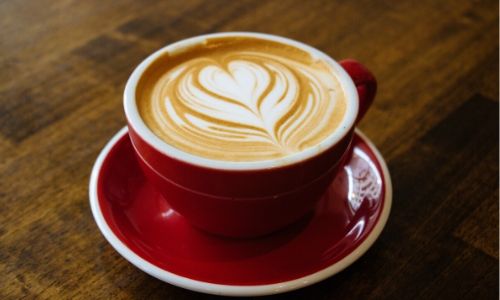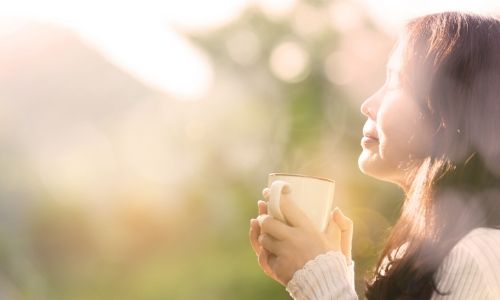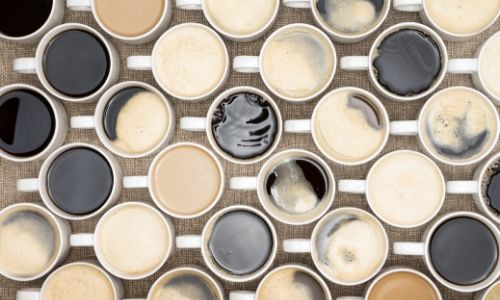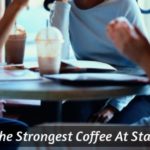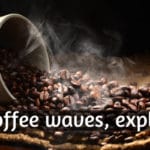Trying to decide between a cappuccino and regular drip coffee ?
You're not the only one. There's a lot of questions surrounding cappuccino vs coffee, such as:
- Which has more caffeine ?
- Is one larger than the other ?
- Are they different coffees ?
- Why does everyone insist on flavoring capps ?
Fortunately, there's answers to all of that. This is going to be a longer explanation (and post), so let's make quick work of it.
First, we're going to tackle what each of these drinks is, and then compare their key points.
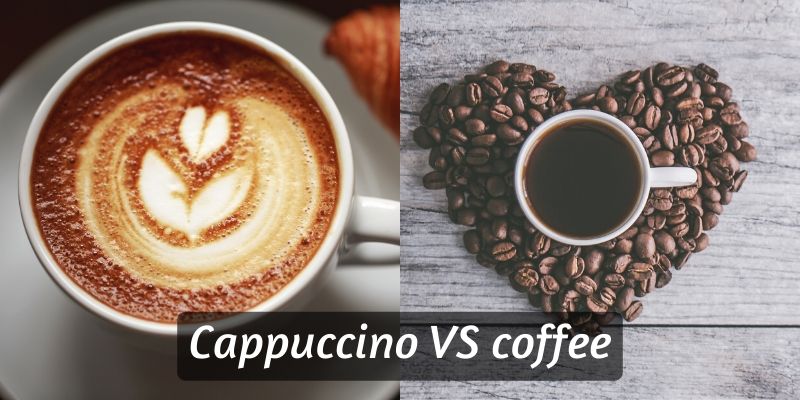
Table of Contents
What is a cappuccino ?
A cappuccino is an espresso-based drink that also contains steamed and foamed milk.
Meaning, you normally get one standard shot of espresso, with 3 to 5 times more steamed and frothed milk on top.
Depending on the quality of the cafe you're buying from, the milk might be a 'dry', flavorless foam or it might actually be microfoam. Which is a very hot milk that's densely packed with tiny, tiny air bubbles.
Proper cappuccino is the latter, and this helps create those pretty patterns everyone's so obsessed with.
You might find that some establishments offer the option of flavoring your cappuccino, while others don't.
This has more to do with customer demand, rather than recipe.
Traditionally cappuccinos are unflavored, but in the past few years more and more people ask for flavored, milkier versions. In truth, those are lattes - the bigger, milkier, sweeter siblings of capps.
What is coffee ?
Coffee is what we all know, but maybe under different names.
Drip coffee, filter coffee, brewed coffee, Moka pot coffee, stovetop coffee, etc.
While each of these brewing methods is different, the end result is the same: not espresso.
Espresso and espresso-based coffee drinks have become a sort of new breed of coffee. So much so that folks stopped referring to it as 'coffee' and only call it 'espresso'.
So this leaves 'coffee' as pretty much anything that's not espresso, but actually brewed coffee.
The most common is drip coffee. I think most of us are acquainted with this one.
It's one of the most common ways to serve coffee in small diners, road stops, gas stations, and in many homes.
Generally, coffee is brewed and served in larger portions than espresso and is milder in taste.
Which one has more caffeine ?
The answer to this is an endless debate. Let me explain.
Each brewing method out there extracts flavor and caffeine from the ground coffee you use.
Some might do it a little better, some a little less.
What matters more than the brewing method is the exact coffee bean you use, and how much of it.
That's it. That's the big secret.
Also, there isn't really a fixed recipe for each brewing method.
True, an espresso is usually made with 7 to 9 grams of ground coffee, but this might result anywhere between 60 mg caffeine to 130.
Depending on what coffee bean you use and how you use it, you may get a little more caffeine.
If you absolutely need a figure, most folks agree that a standard shot of espresso has about 60 mg of caffeine.
But that can be higher or lower, if you change the bean. And I don't mean switching from mild Arabica to strong Robusta.
There are differences between various Arabica beans, depending on where they've grown and how good the soil was. Or, if they're a certain subspecies that's meant to be stronger or more flavorful.
All this might be a little hard to accept, since most menus out there will state a certain caffeine level next to their coffee drinks. The trouble is, each cup of coffee is different and unless it's all brewed from the exact same batch of coffee beans, it won't have the same caffeine.
Most of the time, those figures are guidelines, rather than actual scientific measurements.
I'll get into this a little bit later, because there are a couple differences in caffeine between cappuccino and brewed coffee.
The way you add milk to either of them is very different
Another key point to keep in mind is milk and creamer.
If you don't take you coffee black, then you're going to add at least some measure of milk.
Depending on how you like your drink, you might lean towards cappuccino or regular coffee.
Cappuccino always has steamed and frothed milk, and ends up very creamy.
The milk is incorporated into the drink, before it's handed to you.
Whereas drip coffee or brewed coffee does not come with milk by default. Some waiters or baristas might ask you if you want milk, but most often you'll have to ask for it yourself.
And most often, the milk is added cold, unless the cafe can warm it for you.
Some key differences between cappuccino and coffee
There are significant differences between cappuccino and coffee, and we'll discuss the most important ones next.
These are also the key points that will help you figure out which drink to order, depending on what you're looking for and what you like.
Keep in mind that not all cafes or establishments abide by these 'rules'. For example you might find that one cafe's cappuccino is way stronger than another's drip coffee, and that's all on the barista.
That being said, here are they key differences between cappuccino and brewed coffee.
1. Cappuccinos are milky and creamy
We've established that cappuccino has milk added to it before it's even handed to you.
This milk is usually anywhere between 3 to 5 times more than espresso, by volume.
Steaming and frothing milk makes it double in size, so for example if you need 4 oz/120 ml of milk in volume, you only use 2 oz/66 ml.
Even so, the air added is so well incorporated that the milk ends up with a creamy, velvety texture that's going to blend nicely with the crema on top of the espresso.
The steamed milk will blend with the espresso on the bottom, and together create a slightly thick, creamy drink that's already perfectly blended.
And, if this matters to you, it comes hot. Both the espresso and the milk are screaming hot when blended into a cappuccino.
Regular coffee comes hot, but often without milk.
And most often, the milk is added by the customer, from the little 10% fat cups, or creamer, or regular milk. These are usually readily available on the counter or the barista/waiter might hand them to you.
Seeing as drip coffee or brewed coffee is most common in homes, or small businesses meant to serve plain coffee, the milk isn't really an important figure.
So, in short, if you like your coffee milky and creamy and generally on the flavorful side, you might want to opt for cappuccino.
If you don't mind if it has milk or not, and just want coffee, you might get along better with regular coffee.
2. Regular drip coffee might end up having more caffeine
Back to the discussion we had earlier, about caffeine and which drink has the most.
It's true that caffeine levels vary wildly from one coffee bean to another, and depend a lot on how much coffee you use while brewing.
But, if we were to take a single coffee batch and use the exact same amount to brew drip coffee and a shot of espresso, there would be a difference.
The difference wouldn't be sky-high, but it might be noticeable for some. Exactly how many milligrams of extra caffeine will be present will depend on the coffee beans themselves.
But, it's the brewing method that determines which coffee ends up with more caffeine.
If you guessed drip coffee, you're right.
Drip coffee, and most other brewed coffees hold the hot water in contact with the coffee grounds for much longer than espresso.
If a shot of espresso is usually done in 15-30 seconds, a cup of drip coffee is dome in 2-4 minutes, depending on the amount of ground coffee and water.
This is the same reason French press and cold brewed coffee are routinely ranked as the most caffeinated coffees out there.
They, too, have a longer brew time which in turn leads to extracting as much caffeine as possible.
So in short, you might find that drip coffee is a bit stronger than espresso. Not in terms of flavor, only in caffeine.
3. Cappuccino is more of a morning drink
Yet another difference between capps and coffee is when they're generally taken.
Normally, each person takes their coffee whenever they please.
But it seems most of us have a bit of a pattern to our preferences.
Most folks prefer to take their cappuccino in the first half of the day. This is mostly due to it being blended with a lot of milk, and possibly some sugar.
This slows down digestion and makes it a heavier drink if consumed in the evening.
Drip or brewed coffee is usually taken at any point during the day, especially if taken without any milk at all.
So if you're wondering which to drink in the morning, you can take either of them.
But if you need a little pick me up in the evening, after a long, hard day then maybe brewed coffee would be better.
4. Drip coffee and cappuccino use different size grounds
Another important distinction between drip coffee and cappuccino is the grind size they use.
If you think this isn't really much of an issue, here's why it matters.
Each grind size brews differently. Very small and fine ground coffee, like for espresso and thus cappuccino, brews in seconds.
Medium sized grounds like those for most versions of brewed coffee brew slower, and need several minutes to be fully done.
If you were to use very fine coffee grounds for drip coffee, you'd end up with a drink too bitter and harsh. It would be overextracted and need all the milk and sugar in the world to taste acceptable.
And if you were to use medium ground coffee to pull a shot of espresso, you'd end up with a very weak shot, with barely any crema at all.
This all translates into how the drink's flavor will develop.
It's also the reason why espressos are so very strong and have a kick to them. Very finely ground coffee tends to release a little too much flavor, and since there is very little liquid it seems even more concentrated.
You'll also note that your cappuccino seems denser than drip coffee, even if the milk added isn't as creamy as it should be.
So which one should you get ?
This is up to you and your preferences.
Most folks who are just looking for a tasty drink that's got a nice coffee flavor will go for a cappuccino. It usually looks pretty and is served in a nice cup that may or may not have their name on it.
And for those who don't care much for milk, pretty patterns or a creamier mouthfeel, they usually go for a drip coffee.
In my experience drip coffee (or any sort of brewed coffee) is a little more mundane, and allows the mind to think on other things, instead of focusing on the coffee.
It might just be me being biased, since I happen to own a drip filter.
Conclusion
You choose whichever drink you prefer. Settling the differences between cappuccino and coffee seemed to be an important thing to do, seeing as there's quite a few people out there wondering which is why, and why it matters.
If you want to know more about coffee or tea, feel free to check the related articles below. Who knows what else you might find ?


